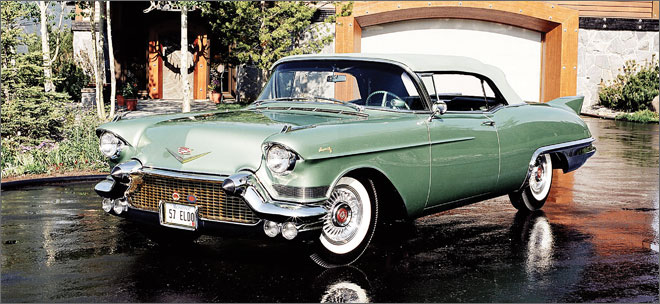In 1953, General Motors wowed the automotive world with the introduction of a 50th Anniversary Buick, the Skylark, as well as the Oldsmobile Fiesta, the Cadillac Eldorado and a fiberglass sports car called the Corvette. All four cars were successful, but it was the mighty Cadillac that retained the most star power. Today, 1950s-era Cadillacs are considered to be the icons of American styling for the period and are highly collectible. Arguably, the great granddaddy of them all is the 1957 Eldorado Biarritz convertible.
The current owner purchased this example in the late 1990s and spared no expense in its restoration in the early 2000s. Every receipt from day one in the refurbishment process was saved and comes with the car as part of its provenance. The quality of the paint is matched by the underlying bodywork, which leaves nothing to be desired; the enormous panels are all straight and true, with gaps to match. The same dedication to perfection can be seen in the way the Elysian Green convertible top is fitted with lines up to the window.
This Cadillac had won the AACA First Junior and Senior awards, Grand National First at the Cadillac LaSalle meet in Rhode Island and Best in Class at Amelia Island in 2000. The car won Grand National Best of Show Postwar in 2001 with 99.25 points and has been looked after with the utmost care and remains in award-winning condition.
SCM Analysis
Detailing
| Vehicle: | 1957 Cadillac Eldorado Biarritz Convertible |
| Years Produced: | 1957-1958 |
| Number Produced: | 4,765 (1,800 in 1957 model year) |
| Original List Price: | $7,750 |
| SCM Valuation: | $80,000-$150,000 |
| Tune Up Cost: | $125 |
| Chassis Number Location: | Lubrication plate on left front door |
| Engine Number Location: | Right front face of engine block |
| Club Info: | Cadillac LaSalle Club |
| Website: | http://www.Cadillaclasalleclub.org |
| Alternatives: | 1957 Buick Super Riviera Convertible, 1956 Packard Caribbean Convertible, 1957 Oldsmobile Starfire J-2 Convertible |
This car, Lot 40, sold for $247,500, including buyer’s premium, at The Worldwide Group Atlantic City, N.J., auction on Friday, February 18, 2011.
The Cadillac Eldorado was introduced in 1953, with much fanfare, as part of General Motors’ 50th Anniversary. The Eldorado was part of a trio of luxury cars that showcased their trendsetting designs and luxurious appointments. Priced at $7,750, the Eldorado found just 532 buyers in its debut model year. Sales volume, however, soon increased, and Cadillac was soon offering a premium-priced car that, while selling in limited numbers, was profitable.
In 1956 Cadillac introduced a pair of Eldorados: a new Seville hard top and the Biarritz convertible that was named after the Basque resort town. Cadillac completely redesigned the Biarritz for 1957, with a new X-member chassis that provided structural rigidity as well as a three-inch-lower profile. Without side rails there was, of course, no lateral-impact protection, but safety was not a major concern in the 1950s.
Ron Hill, who was a 22-year-old designer at the time, is credited with the distinctive sloped rear deck that is flanked with sharply pointed fins. The hood ornament was eliminated, and the rear wheel opening remained skinless with “chipmunk cheek” rear quarter panels. The 300-horsepower, 325-ci V8 was now standard fare for the Biarritz, and the twin-pot 325 with the famed “batwing” air cleaner was installed as an option. Only 1,800 were produced, although the WWG catalog listed the number as 1,600.
Gadgets and gremlins
The Biarritz was loaded with gidgets and gadgets, such as a foot–pedal radio control, six-way power seats, power-release and closing-assist trunk—and the ever-troublesome hydraulic air bag suspension.
Imagine the frustration of opening the garage door and seeing your Eldorado listing to port because of an air bag leak. Cadillac actually released a kit to convert the car back to coil springs, but the evil culprit was usually the small valve that was not unlike a standard tire stem valve. A more substantial valve from a tractor tire would often solve the problem. Another gremlin lived inside the two-cylinder pump that attached to the rear of the generator and controlled the whole operation.
High prices for proper restorations
The 1957 Cadillac Biarritz was expensive in its day. A fuel-injected Chevy Bel Air convertible would cost you a little over three grand, but the Biarritz was closer to eight. Prices for properly restored examples were in the $125,000-$150,000 range a few years back, but RM sold a splendid example from the McMullen collection in June of 2007 for $357,500, and The Worldwide Group sold an equally spectacular example at their 2010 Auburn, IN, sale for $363,000.
Lesser examples still sell in the aforementioned range, with the quality of restoration the determining factor.
Restoring these cars is a time-consuming project, and time equals money when paying the man. The Biarritz was expensive to build in 1957, and if you want an award-winning car, the same attention to detail must be applied today. This example was restored in early 2000, and today shows only minor signs of use. With a long list of awards—albeit a few years back—and based on the two other sales of high-point examples, we feel our auction reporter at the Atlantic City auction was right-on when he declared this well bought—and well sold.
